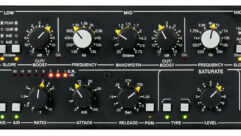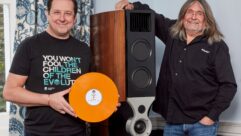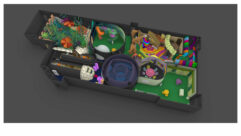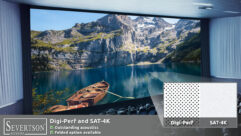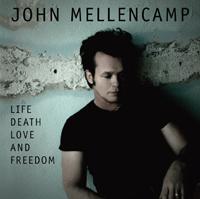

The Quest for Sound Quality
Look on the case of a CD bought in the late 1980s or early 1990s and there’s a good chance it will include a three-letter combination, such as ADD, indicating how the album was recorded, mixed, and mastered in analog or digital at each stage.
Look on the case of a CD bought in the late 1980s or early 1990s and there’s a good chance it will include a three-letter combination, such as ADD, indicating how the album was recorded, mixed, and mastered in analog or digital at each stage. There’s also a good chance the CD’s liner notes will provide more detail.
Case in point: Pink Floyd’s 1987 album, “A Momentary Lapse of Reason,” was “recorded digitally, with the exception of the acoustic drums and bass guitar” and “mastered direct to metal.”
John Mellencamp’s “Life, Death, Love and Learning,” released this past July 15, is the first album available using CODE.
Good luck finding that information on most CDs sold today, let alone digital media such as MP3s. Some in the music industry interpret that as acknowledgement that the factors affecting audio quality don’t matter to most fans at least not as much as the ability to download a song to an iPod or cellphone.
“The real problem is that consumers think the files they buy from iTunes or steal from the peer-to-peer (P2P) services are good enough,” says Elliot Mazer, who has produced albums for artists such as Linda Ronstadt and Janis Joplin and also serves as a consultant to companies such as Warner Music Group. “They sound awful, but convenience has trumped quality for now.”
Even so, others believe there’s a market not only for high-quality albums, but also for branding the underlying technology and using it as a market differentiator. The latest example is CODE, developed by producer-musician T-Bone Burnett and a group of engineers. CODE (or “XO?E”) is described as “a proprietary audio technology that creates high-definition audio files that are virtually indistinguishable from the original master tapes.”
The are a few reasons why technologies such as CODE bear watching by AV integrators. One reason is that business users’ AV choices often are influenced by their experiences as consumers, so if new formats create a buzz in the consumer market, there’s a good chance clients will ask about or specify them. Blu-ray is one example.
Another reason is that at least for now high-quality formats are aimed largely at the home theater and entertainment markets. So integrators serving discerning customers in those sectors need to be up to speed on what’s perceived as the latest and greatest recording formats. After all, an audio system’s quality depends in part on the quality of its source material. So if a client uses sources that are compressed, such as MP3, then an AV integrator could face the challenge of designing a system so it won’t reveal the limitations of its sources.
“When you compress files down to 128 kbps, like iTunes, if you turn it up, it comes apart [in terms of] sound quality,” says Scott Bahneman, CEO of Incline Village, Nev.-based Music Giants, which specializes in music downloads that use lossless technologies in order to improve quality.
IMPROVING ON THE ORIGINAL
Released in 1972, Neil Young’s “Harvest” went multi-platinum. As its 30th anniversary approached, Young called Mazer, the album’s producer, about doing a DVD-Audio version in 5.1 surround sound.
“I thought it was crazy to attempt to make a new mix of a record that so many people love,” Mazer says. “We agreed to do it, and if we were not pleased, throw it out. Mixing took over a year before we figured out the best way to present that album in surround. The idea is that you are in the studio amongst the musicians.”
Indeed, one long-standing goal of recording is to capture and then faithfully recreate what went on in the studio. But it’s tough to recreate something that never happened or happened in different places at different times. (For an example of how a long-distance jam session is facilitated, see “Virtual Jam Session,” December 2007)
“Mostly there is no real studio experience today,” Mazer says. “Most records are made one instrument at a time, and many times at home.”
Another challenge is the ever-growing variety of devices used for listening to music, including MP3 players and cell phones, which sometimes influence how albums are recorded. In the 1980s, for example, some artists in the final stages of recording would put the album on a cassette and then listen to it on a boom box or a car stereo. They would then go back and tweak the mix to make it sound as good as possible in that environment. The reason: They knew that most of their fans would be listening to the album on a boom box or in a car.
That practice continues today, albeit with a new generation of devices and media. “We use various consumer-friendly playback devices to make sure that our mixes will translate to how consumers will hear them,” Mazer says. “I have a Klipsch iPod speaker system that sounds great. It has a big and true sound at low volumes.”
The ability to capture a performance is determined partly by the technology available at the time. Applying a new technology to an old recording doesn’t necessarily overcome the source material’s limitations, a reality that sometimes goes unmentioned.
“I attended a big press event where the presenter played a Beach Boys tune from 1966 “Sloop John B” and referred to it as ‘high-definition audio,'” says Mark Waldrep, president of Los Angeles-based AIX Media Group, which specializes in DVD-Audio, tells PRO AV. “It was done on a four-track analog machine running at 15 ips [inches per second]. Simply putting the original audio on an HD platform doesn’t magically transform the fidelity to the new standard.”
FOCUSING ON QUALITY
AIX and MusicGiants are among the companies targeting people who aren’t willing to trade audio quality for convenience. In the case of MusicGiants, the process of converting an existing song or album begins with about $100,000 worth of proprietary hardware and software. The set-up includes a Windows Media Audio Lossless (WMAL) format customized by Microsoft for MusicGiants.
Engineers use the gear to create WMAL files, which then are used to do bit-for-bit transfers of DVD-A recordings into WMAL recordings. Music-Giants makes sure that nothing gets lost by reversing the process to confirm that all of the song’s bits line up with the original.
AIX, meanwhile, aims to improve the listening experience partly by offering multiple 5.1 surround-sound mixes, including “stage” and “audience” audio streams that users can toggle between.
“The stage mix is much more aggressive in terms of the amount of sound directed to the left and right surround speakers,” Waldrep wrote in a 2007 Audio Engineering Society (AES) paper. “The intent is to place the listener in the midst of the musicians. The audience mix moves the listener’s point of view back to the ‘best seat in the house’ by placing room ambience in those same channels.”
AIX’s studio process includes recording 24 to 36 tracks simultaneously, as well as the frequent use of ORTF mics, named after the Radio France division that developed the twin-cardoid system in the 1960s.
“The traditional method of placing a single cardoid microphone in front of an acoustic guitar, for example, has been found to limit the depth of the sound source upon playback,” Waldrep’s paper notes. “An ORTF pair placed in front of the same acoustic guitar provides a much greater sense of envelopment, depth, and expansiveness.”
AIX keeps everything digital through the editing, mixing, and mastering. “At no time do we convert the 96 kHz/24-bit digital tracks to analog in order to process or modify them in any way,” Waldrep wrote. “The only manipulations that are applied during mix down are level and placement within the 5.1 surround field. No equalization, artificial reverberation, ordynamic processing is used. Instead, careful selection and placement of microphones during the session ensures proper tonal and dynamic balances.”
CRACKING THE CODE
Although CODE has generated plenty of buzz in the music industry, there’s not a lot of publicly available information about the nuts and bolts of what it does. (PRO AV attempted to contact Burnett, both directly and through Mazer, but was unsuccessful. At press time, he was on tour with Alison Krauss and Robert Plant, but his representatives offered PRO AV a chance to catch up with him about CODE later in the year.)
One engineer involved with the recording of John Mellencamp’s “Life, Death, Love and Freedom” the first album to use CODE told PRO AV that the format is used at the mixing stage. So far, the only other publicly released details about CODE are from a press release on Mellencamp’s Web site:
“T-Bone Burnett and his team of engineers developed CODE, a proprietary audio technology that creates high-definition audio files that are virtually indistinguishable from the original master tapes. The resonance, warmth, and presence that has been realized with CODE is unprecedented in the digital era.
“The CODE version … is a DVD that will come packaged with a standard CD version of the album, available at all retail outlets, at no additional cost to the consumer. The CODE disc is playable on virtually all DVD machines, including stand-alone players and drives integrated into computer systems.
“The DVD’s content can be copied into most computer music software including iTunes and can, then, be downloaded onto personal music players such as the iPod.”
Some in the recording industry suspect that CODE is simply a new brand name for an existing format.
“From what I know about the DVD formats DVD-Audio, DVD-Video, and DVD-ROM the CODE technology is not a format at all but a marketing scheme much the same as DAD [Digital Audio Disc] was for Classic Records some years ago,” says AIX’s Waldrep. “In the case of DAD, they simply used the improved PCM [pulse code modulation] audiospecs of the DVD-Video format to put better quality audio out.”
Waldrep speculates that CODE might use the HD Audio standards of the DVD-Audio format, which supports up to 192 kHz and 24 bits in stereo.
“But it is more likely that they are using DVD-Video and 96 kHz/24-bitstereo PCM audio,” Waldrep says. “If they are altering or processing the PCM masters to sound more like tape and yes, people do modify the sound of pristine PCM digital audio to make it sound more like analog tape they could brand it as CODE.”
Time will tell. For now, the fresh emphasis on quality audio is welcome whatever it’s called.
Tim Kridel is a freelance writer and analyst who covers telecom and technology based in Columbia, Mo. He can be reached at [email protected].


